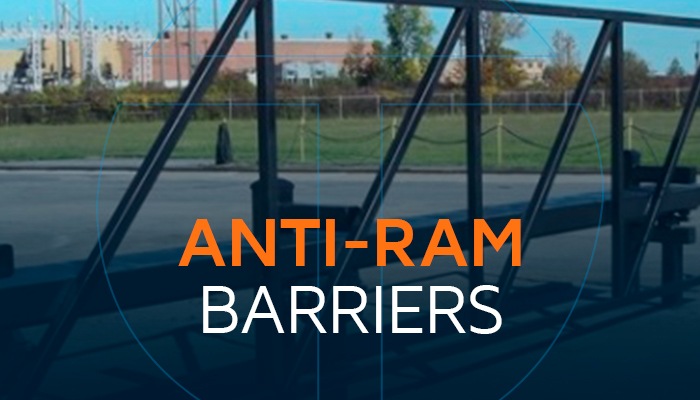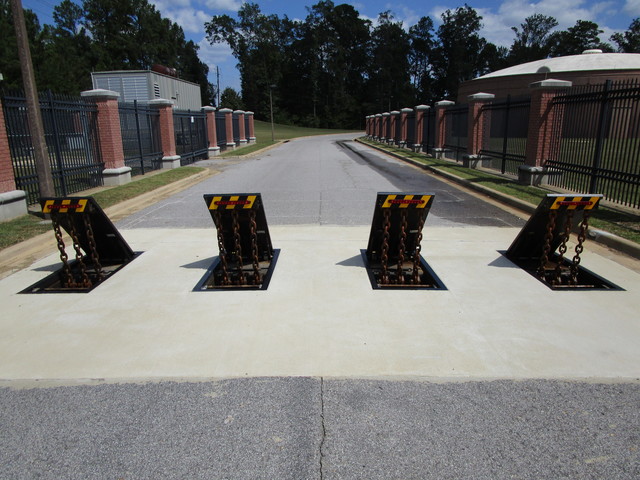The smart Trick of Wedge Barriers That Nobody is Talking About
Wiki Article
9 Simple Techniques For Wedge Barriers

The Main Principles Of Wedge Barriers
g., springtime assistance 65 )may be fixed to the end of the springtime pole 58 to allow compression of the springtimes 60. As the springtimes 60 are pressed in between the springtime supports 62, the springtime setting up 54 produces a pressure acting upon the camera paired to the springtime pole 58 in an instructions 66. The staying force applied to the cam to deploy the wedge plate 16 may be provided offered an electromechanical actuator 84 or other various other. As such, the springtime setting up 54 and the actuator 84(e. g., electromechanical actuator)may operate together to translate the camera and lift the wedge plate 16.
As mentioned over, the springtime assembly 54 applies a consistent force on the web cam, while the electromechanical actuator may be controlled to apply a variable force on the web cam, consequently allowing the training and decreasing( i. e., releasing and pulling back )of the wedge plate 16. In certain personifications, the consistent pressure applied by the springtime setting up 54 may be flexible. g., electromechanical actuator) is handicapped. As will be valued, the spring assembly 54 may be covered and secured from debris or various other aspects by a cover plate(e. g., cover plate 68 revealed in FIG. 4) that may be considerably flush with the elevated surface area 38 of the foundation 14. As stated above, in the released position, the wedge plate 16 serves to obstruct accessibility or travel past the barrier 10. For instance, the barrier 10(e. g., the wedge plate 16 )might obstruct pedestrians or automobiles from accessing a building or pathway. As gone over above, the obstacle 10 is affixed to the support 30 secured within the foundation 14,

front brackets 71. Consequently, the affiliation assemblies 72 might pivot and rotate to make it possible for the collapse and expansion of the linkage settings up 72 throughout retraction and deployment of the bather 10. The affiliation assemblies 72 reason movement of the wedge plate 16 to be restricted. If a car is taking a trip in the direction of the released wedge plate 16(e. For example, in one condition, the safety and security legs 86 may be expanded throughoutmaintenance of the barrier 10. When the safety and security legs 86 are deployed, the safety and security legs 86 sustain the weight of the wedge plate 16 versus the surface area 12. As a result, the lifting mechanism 50 might be visit the website shut off, serviced, removed, replaced, etc. FIG. 5 is partial perspective sight of an embodiment of the surface-mounted wedge-style barrier 10, highlighting the webcam 80 and the web cam surface areas 82 of the training system 50. Specifically, 2 web cam surface areas 82, which are described as reduced webcam surface areas 83, are positioned below the camera 80. The lower camera surfaces 83 might be fixed to the surface area 12 (e. As an example, the reduced cam surfaces 83 and the installing plate 85 may form a solitary piece that is protected to the anchor 30 by bolts or various other mechanical bolts. Additionally, two camera surface areas 82, which are described as upper web cam surfaces 87, are positioned above the web cam 80 and coupled to (e. In other personifications, intervening layers or plates might be positioned in between the surface area 12 and the lower cam surfaces 83 and/or the wedge plate 16 and the top web cam surface areas 87 As pointed out above, the web cam 80 equates along the cam surface areas 82 when the wedge plate 16 is lifted from the withdrawed placement to the released setting. Additionally, as discussed over, the spring assembly 54 (see FIG. 3 )might provide a force acting upon the cam 80 in the instructions 102 via spring pole 58, which might lower the pressure the electromechanical actuator 84 is needed to use to the web cam 80 in order to activate and raise the wedge plate 16. 1 )to the released setting(see FIG. 4). As shown, the webcam 80 includes track wheels 104(e. g., rollers), which get in touch with and equate along the web cam surfaces 82 pop over here throughout operation.
Report this wiki page